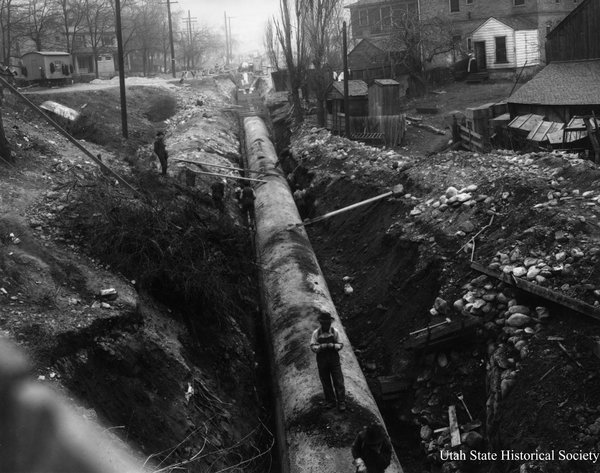Dublin Core
Title
Description
In 1852, land surveyor and explorer Howard Stansbury called the site for Salt Lake City “… most beautiful: it lies at the western base of the [Wasatch] mountains... watered by several little streams, which, flowing down from the eastern hills, form the great element of fertility and wealth to the community.” These seven mountain creeks – City, Red Butte, Emigration, Parleys, Mill, Big Cottonwood, and Little Cottonwood – are now diverted into stormwater pipes beneath our neighborhoods. Totally gone.
Each of these major canyons in the Salt Lake Valley carry melted snow and runoff to the Jordan River and into Great Salt Lake. These streams have long provided homes and food for a variety of wildlife, and the surrounding vegetation absorbed precipitation and mitigated flooding. Indigenous peoples hunted, fished, and gathered here. Early white settlers used the canyons as pathways to the valley and beyond. The streams also provided water and supported industry.
But a century of taming and tapping urban creeks left them degraded. Pollution from industry and development tainted water quality. To control flooding, creeks were channelized where they entered the valley, but banks became steep and eroded. This led to the burial of creeks -- dubbed a nuisance -- in the early 20th century. But even as creeks gave way to concrete and asphalt, bricks and mortar, there were still voices of opposition. In 1921, a Deseret News editorial anticipated the damaging outcome, writing, “To hide completely the flowing water within a conduit and to make of the street a stretch of ordinary pavement would be to throw away opportunity for which many cities would gladly pay a million dollars.”
Today in Salt Lake County, an estimated 21 miles of creeks are culverted underground, and 87 miles have impaired water quality. But community groups and neighborhood residents are working to uncover and restore Salt Lake Valley’s buried creeks. This process is called “daylighting” and is an effort to build a more sustainable water environment for both humans and nature.
Creator
Source
_______________
See Brian Tonetti, Seven Canyons Trust section, exhibition file for Confluence, curated by Annie Burbidge Ream and Virginia Catherall, Utah Museum of Fine Arts, Salt Lake City, Utah, 2021. The Seven Canyons Trust works to uncover and restore the buried and impaired creeks in the Salt Lake Valley. See also “City Creek Should Be Preserved,” Deseret News, July 8, 1921; Howard Stansbury, Exploration of the Valley of the Great Salt Lake of Utah, United States Senate, 1852.

